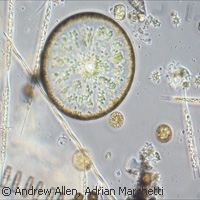Urea cycle behind evolutionary success of diatoms
Despite their ubiquity and diverse roles, marine diatoms, the main component of phytoplankton found in abundance in the ocean and thus the basis of the marine food chain, remain a mystery. Recently, an EU-funded international consortium of scientists has discovered that at least one diatom species, Phaeodactylum tricornutum, uses a molecular pathway previously found only in mammals: the urea cycle. Their research, published in the journal Nature on May 12, was funded in part by the 'Understanding diatom biology by functional genomics approaches' (DIATOMICS) project which received EUR 1.8 million under the 'Life sciences, genomics and biotechnology for health' Thematic area of the European Commission's Sixth Framework Programme (FP6). The urea cycle is a metabolic pathway used in mammals to incorporate excess nitrogen into urea and remove it from the body. However, it appears to play a far more wide-ranging role in the diatoms. The urea cycle is key to the distribution and recycling of inorganic carbon and nitrogen, and also helps diatoms recover from short-term withdrawal of nutrients. In the laboratory, scientists reconstructed the upwelling phenomenon observed in the oceans: this is the upward movement of nutrient-rich water from the deep ocean to the surface, where diatoms are abundantly distributed. Diatoms responded immediately to the availability of an augmented food supply by increasing their metabolic and growth rates. Genes that have reached the diatom genome through lateral gene transfer - the movement of genes between distantly related organisms - are considered responsible for this capacity. In previous research, scientists had found that some of the diatom's genes have counterparts in chloroplasts and bacteria, proof of how much there is still to learn about these multifaceted organisms. Going one step further in this line of research, lead author of the study, Dr Andrew Allen from the J. Craig Venter Institute in the United States, together with his colleagues, explored the cellular mechanisms for nutrient utilisation in the environment. This led to the finding that the urea cycle metabolites facilitate the diatom recovery after short-term withdrawal of nutrients. 'It appears that the animal urea cycle, which is critical for cellular export of carbon and nitrogen waste, was co-opted from an ancestral pathway that originally evolved as a nitrogen and carbon recycling and recovery mechanism,' explained Dr Allen. In other words, diatoms have followed a fundamentally different evolutionary path from green algae and other closely related organisms. 'This study provides fascinating insights into how diatoms have evolved to become the dominant primary producers in many ocean regions,' added Dr David Garrison, Programme Director at the Division of Ocean Sciences of the National Science Foundation in the United States, which funded the research along with the European Commission. Diatoms are at the base of the marine food chain and have been credited with absorbing as much carbon dioxide, a major greenhouse gas, as all of the world's tropical rain forests. Beyond nourishing animals of all kinds and helping to keep the planet's carbon in balance, the single-cell organisms are also valued by scientists as indicators of whether the water is deficient in minerals and nutrients, or contaminated.For more information, please visit: Max Planck Society: http://www.mpg.de/en National Science Foundation: http://www.nsf.gov/ Nature: http://www.nature.com/nature/index.html
Countries
Czechia, Germany, France, United States



